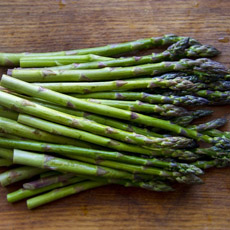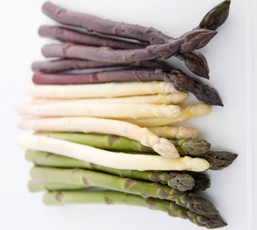TIP OF THE DAY: Spring Asparagus
 [1] Freshly cut asparagus (photo © Baldor Food).
|
Asparagus is our favorite harbinger of spring, along with big artichokes, fava beans, green garlic, morels, nettles, ramps and spring peas (a.k.a. English or garden peas). Once upon a time—in your mother’s, grandmother’s or great-gran’s generation, depending on your age—people who preferred fresh produce had to get their fill during the growing season. Some growing seasons were quite brief. Imported produce had yet to emerge in the off season, to meet the demands of people who wanted asparagus—or peaches or any other fruit or vegetable—year-round. When asparagus or peaches were out of season, you could buy them canned or frozen. Now asparagus is available year-round, imported from the Southern Hemisphere during the Northern Hemisphere’s off season. That means carbon miles, plus waning freshness as the they travel a long distance. In the U.S., spring is the best season for fresh, affordable asparagus. April through late June is prime asparagus season, so get your fill while you can. In the olden days, spring asparagus were served as a side or a first course: buttered spears with a wedge of lemon and/or lemon mayonnaise. They were pickled and served with cocktails, turned into soup and, for people of Italian heritage, added to pasta and risotto. While most of the asparagus grown are green (some with green tips, some with purple tips), you can find purple and white in specialty produce stores and farmers markets. Here are the differences among green, purple and white asparagus varieties. We’ve even seen pale pink asparagus, possibly a mutation of the purple. |
|
|
WAYS TO SERVE ASPARAGUS Asparagus blends well with most dishes. |
||
|
THE HISTORY OF ASPARAGUS The asparagus plant, Asparagus officinalis, is a member of the lily family, Asparagaceae, which also includes agave, and flowering plants such as lily of the valley and star of Bethlehem. There are more than 300 species of asparagus, most of which are grown as ornamental plants. Asparagus originated in the eastern Mediterranean region, but today is grown worldwide. It was first cultivated more than 2,000 years ago. The ancient Egyptians, Greeks and Romans prized asparagus for its unique flavor, texture and alleged medicinal qualities. The vegetable gained popularity in France and England in the 16th Century; King Louis XIV of France enjoyed this delicacy so much that he had special greenhouses built to supply it year-round. Early colonists brought it to America. Asparagus is a perennial plant raised in furrowed fields. It takes about three years before the plants produce asparagus. The delicate plant needs a temperate climate and requires much hand labor in all phases of cultivation. The spears are cut by hand—backbreaking work—when they reach about 9 inches in length. Asparagus is nutritious: a good source of calcium, magnesium, vitamin B6 and zinc; and a very good source of copper, dietary fiber, folate, iron, manganese, niacin, phosphorus, potassium, protein, riboflavin, selenium, thiamin, vitamin A, vitamin C, vitamin E (alpha tocopherol) and vitamin K, plus the antioxidant flavonoid rutin. It has no fat or cholesterol and is very low in sodium. Asparagus is very low in calories (27 per cup) and contains no fat or cholesterol. There are three varieties of asparagus—green, purple and white. |
|
|
|
While white and purple asparagus are creations of modern growing techniques, green asparagus has been enjoyed since ancient times. There is a recipe for it in oldest surviving book of recipes, De Re Coquinaria, Book III, written by Marcus Gavius Apicius in the third century C.E. |
||


